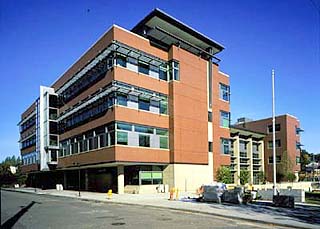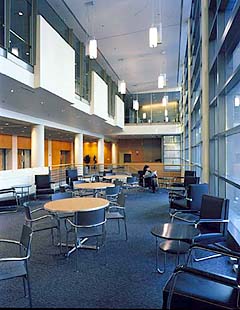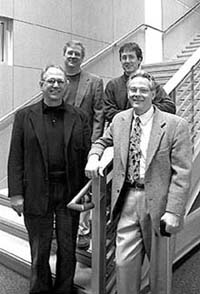|
Subscribe / Renew |
|
|
Contact Us |
|
| ► Subscribe to our Free Weekly Newsletter | |
| home | Welcome, sign in or click here to subscribe. | login |
Construction
| |
March 1, 2000
Project of the Month: A livable law school at Seattle University
Special to the Journal
 |
Jim Bond has devoted his career to shaping the talents and character of aspiring lawyers in the Pacific Northwest. The law school dean also clearly likes the subject of architecture and his new academic home, designed by Olson/Sundberg Architects on the campus of Seattle University. The school recently moved to SU from the University of Puget Sound in Tacoma.
|
Sullivan Hall 12th Avenue & Columbia Street
Owner:
Architect:
Completion date:
Project size:
Construction cost:
Associate architect and interior designer:
Structural engineer:
Civil engineer:
Mechanical, electrical and
telecommunications engineer:
Audio/visual presentation
systems designer:
Lighting designer:
Acoustical consultant:
General contractor:
|
Although they do not use these words, the students and faculty, according to Bond, have shown their sincere approval of the building by voicing only one complaint: “Not enough seating.” Chairs in the old law school went empty at many times of day because no one wanted to sit there, but the seating areas in the atrium at Sullivan Hall are choice vantage points in a very interesting environment.
In the expansive three-story atrium that is the circulation hub and heart of the building, students and their gear settle on soft and moveable furnishings that serve as round-the-clock rookeries. From various positions around the center of the atrium, students and faculty can survey the ramps, stairways, lounge areas and outdoor plaza.
A café with data ports at every table provides another seating and study option.
Even in the second floor lounge, which lies behind a series of partial walls, gaps in between provide light and views from the larger atrium space. And inside, the walls accommodate the school’s growing art collection.
Schools of law are typically highly independent centers on campus, and in that tradition, the law school was programmed to provide a 24-hour, seven-day-a-week, specialized environment for students. But the leadership of the university was anxious to make Sullivan Hall, named for the university’s recent and popular president Father William Sullivan, a vital part of the larger campus. A site was selected along the newly important Lower Mall, an axis that runs between the St. Ignatius Chapel on the north and the site for a new student center on the south end. On the east side of the building is 12th Avenue, an arterial newly christened as the center of an urban village in Seattle. Just to the south, Columbia Street breaks in a turnaround in front of the law school.
It was a challenge to create a gateway building on a small parking lot, according to project manager Scott Allen. Yet the building provides a distinct presence for the law school and helps to tie several elements of the developing campus together. The rigorous Modernist lines complement and elevate the architecture of the existing campus buildings, most of which were built in the ‘40s and ‘50s.
The design of Sullivan Hall reflects two important trends: greater openness at Seattle University and the law school’s connection to the larger institution and the neighborhood. The building also embraces the campus through its open atrium and courtyard and also through its law clinic, which is situated on the ground level at the east end facing busy 12th Avenue.
“The Jesuits have gone out into the community,” said Bond.
Because of the architecture of the law school, students and faculty need not leave the building to play a role in the life of the university.

|
The life within can be confirmed by watching the glass-enclosed staircase on the outer wall of the law library, a standout over the South Mall. And in the daytime, at every landing, there is another photogenic view of the campus for the students on the stair inside.
For the 840 enrolled there, the law school offers many opportunities for mixing and escape throughout the day, all without going out the door. The three main levels are on view from many points in the atrium, which is flooded with daylight from the glazed south wall as well as from the skylights. But it is the strength and variety of the connections between the levels that add excitement to the views and draw people through the interior of the building.
Stairways crisscross the east side of the atrium. From the well-trafficked west entrance area, a paved ramp leads gently down to a seating area overlooking the below-grade court and a large stairway leads up to another lounge area. A telescoping stair leads down past the café to the paved lower court, which catches a generous amount of natural light from the direction of the outer courtyard just above and outside.

|
As the building takes on a life of its own, it is becoming clear that Sullivan Hall was also built to be a showcase for art, with many opportunities for installing pieces in grand display as well as intimate views from seating areas. The interior of the building, which was designed in collaboration with associate architect and interior designer Yost Grube Hall of Portland, has made it much easier for the law school to find donors for its increasingly important collection of paintings and sculpture by Northwest artists.
Not all additions to the interior complement the architecture. In a recent tour of the building, Olson/Sundberg principal-in-charge Rick Sundberg noted with some disappointment the large table in the lower court, where he had envisioned smaller and more moveable pieces. And he reacted with dismay to rumors of indoor plants coming soon to Sullivan Hall.
But that’s OK, he said. “The building is strong enough to take these things.”
The Seattle Daily Journal of Commerce and the American Institute of Architects, Seattle Chapter, sponsor the Project of the Month feature.
Design categories include all types of construction with the exception of single-family houses. Projects are selected for the feature with the participation of distinguished architects and other members of the arts and design communities as well as representatives of client groups.
The Project of the Month for March, Sullivan Hall, was selected with the assistance of architect Clint Pehrson and architect Patrick Gordon. For more information about submitting projects for possible feature articles, please contact Peter Sackett at AIA Seattle, (206) 448-4938.
Clair Enlow can be reached by e-mail at clair@clairenlow.com.
Previous columns:
- Project of the Month: Old Ford plant gets a new engine, 02-02-2000
- New life for a landmark, 01-05-2000
- Renovation charts a new course, 09-01-1999
- Designed to transport, 07-01-1998


